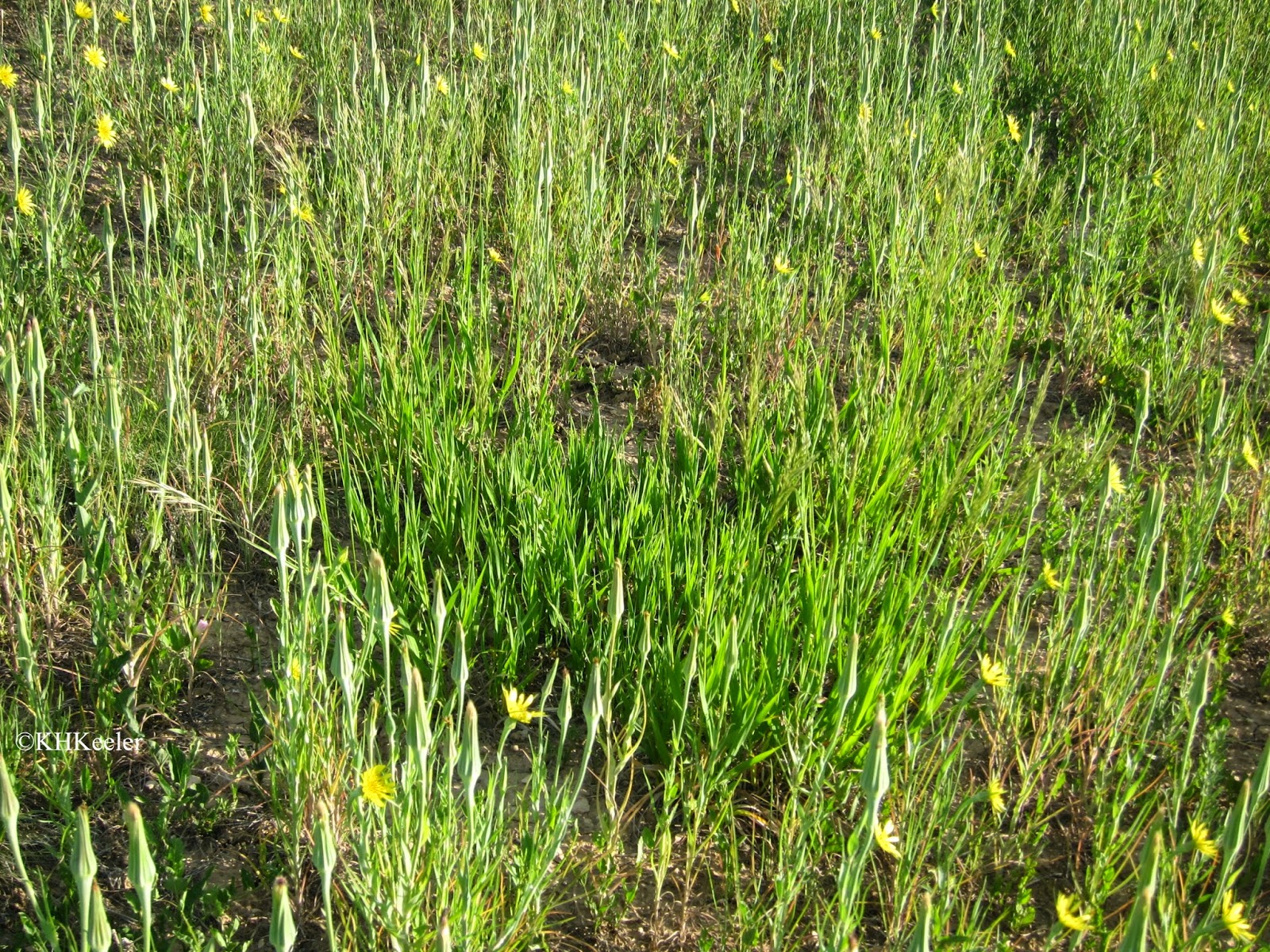Yellow salsify, a plant I always called goat's beard, Tragopogon dubius, is coming up as a weed all over my garden. Right now it looks like the picture below, a spidery little plant.
Cattail Bob Seebeck, Best-Tasting Wild Plants of Colorado, wrote that the young shoots weren't easy to identify unambiguously and beginning foragers should find older plants. Samuel Thayer did not put in any "don't be confused by..." disclaimers. I think the difference is where you look for plants. In the Rocky Mountains there is high plant diversity and salsify is not particularly common. As a city weed or in my back yard, there aren't nearly as many different plants and there are lots of plants of salsify to compare to each other and other things.
They can be very abundant. The field below is turning into Mahaffy Park in Loveland Colorado and has been plowed up, but two years ago it was almost a pure stand of yellow salsify.
As the name of Jack-go-to-bed-at-noon indicates, salsifies open in the early morning and close their flowers by noon. A field bright with their yellow or purple flowers will just look like a field of grass in the afternoon.
It is a pretty plant, and a useful plant, but in my yard, too much of a good thing.
References
Seebeck, B. 1998. Best-tasting wild plants of Colorado and the Rockies. Westcliffe Publisehrs, Englewood, CO.
Thayer, S. 2010. Nature's garden. Forager's Harvest, Birchwood, WI.
In a month or so when they flower, here's how it will look (yellow flowers, not the white ones)
A dandelion relative (in the same family, Asteraceae), the resemblance is strong when its in seed:
Yellow salsify is from Europe and has spread all across North America. It was probably brought as a food. Salsify was widely eaten 200 years ago. As a crop, they raised it for the root, but Samuel Thayer (in Nature's Garden) says the new shoots, flower buds and flower stalks are all not only edible but delicious.
There are three salsifies, three main Tragopogon species, in North America. (The USDA website lists others, but they have very limited ranges link.) All three common tragopogons are from Europe and all three are edible. Two have yellow flowers--yellow salsify, Tragopogon dubius, and Jack-go-to-bed-at-noon, T. pratensis, also called T. lamottei, which is a yellow-flowered plant very similar to yellow salsify, with longer, more continuous, ray (outside) florets, so it looks less "ragged". The third plant is salsify, also called oyster plant or vegetable oyster, T. porrifolius. Its flowers are purple, so it is readily identified. All three are widespread.
Cattail Bob Seebeck, Best-Tasting Wild Plants of Colorado, wrote that the young shoots weren't easy to identify unambiguously and beginning foragers should find older plants. Samuel Thayer did not put in any "don't be confused by..." disclaimers. I think the difference is where you look for plants. In the Rocky Mountains there is high plant diversity and salsify is not particularly common. As a city weed or in my back yard, there aren't nearly as many different plants and there are lots of plants of salsify to compare to each other and other things.
They can be very abundant. The field below is turning into Mahaffy Park in Loveland Colorado and has been plowed up, but two years ago it was almost a pure stand of yellow salsify.
Like a dandelion, the salsifies have a tap root, so if you want to weed them out you have to get most of the root. However, dandelions are perennial, so you can fight the same plant for years if you don't get enough of the root. In contrast, salsify plants are usually biennial, so the plant flowers and dies in two years. The first year it is just a set of thin leaves that get bigger and bigger. The second year it sends up as many flowers as the energy stored in the roots will support, develops the seed head, and dies.
I keep thinking that biennials should have coordinated populations, all the plants flowering in the same year, all the seeds coming up as non-flowering plants together then next year, and then all flowering in the third year, but that's not the case. As soon as a few seeds wait until the second year to come up, the population ceases to be synchronized.
It is a pretty plant, and a useful plant, but in my yard, too much of a good thing.
References
Seebeck, B. 1998. Best-tasting wild plants of Colorado and the Rockies. Westcliffe Publisehrs, Englewood, CO.
Thayer, S. 2010. Nature's garden. Forager's Harvest, Birchwood, WI.
Kathy Keeler
More at awanderingbotanist.com







No comments:
Post a Comment